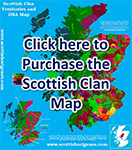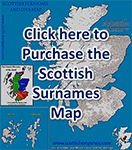You are here
From Gaul to Irish Gael to Scots Gael to Lowland Scot to Gaelic Irish!
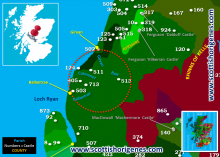 A simple painless commercial ancestral Y-DNA test ONLY explores the paternal line, and it can therefore be used to pin one’s direct male ancestors to specific locations at specific time points in history. In addition, the surnames of one’s Y-DNA revealed genetic relatives can reveal clues to his ancestors ‘ethnicity’ at each specific location and timepoint! For example, one’s Y-DNA revealed 12 marker matches reflect shared ancestry from potentially many thousands of years ago, and when one matches Central European French and German surnames from that timeframe it indicates a Celtic/Gaulish origin. In contrast, if one matches lots of individuals with surnames beginning with ‘Mac’ at the 111 and 67 marker levels it indicates a more recent origin within a Gaelic part of Scotland or Ireland. In this manner one can use one’s Y-DNA matches to track changes in the ethnicity/identity of one’s paternal ancestors over millennia.
A simple painless commercial ancestral Y-DNA test ONLY explores the paternal line, and it can therefore be used to pin one’s direct male ancestors to specific locations at specific time points in history. In addition, the surnames of one’s Y-DNA revealed genetic relatives can reveal clues to his ancestors ‘ethnicity’ at each specific location and timepoint! For example, one’s Y-DNA revealed 12 marker matches reflect shared ancestry from potentially many thousands of years ago, and when one matches Central European French and German surnames from that timeframe it indicates a Celtic/Gaulish origin. In contrast, if one matches lots of individuals with surnames beginning with ‘Mac’ at the 111 and 67 marker levels it indicates a more recent origin within a Gaelic part of Scotland or Ireland. In this manner one can use one’s Y-DNA matches to track changes in the ethnicity/identity of one’s paternal ancestors over millennia.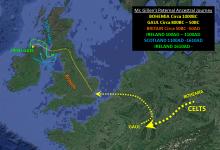
This is beautifully illustrated in this Y-DNA Case Study (CLICK HERE to download). The most distant surnames revealed in the Y-DNA test results reveal a ‘Celtic’ Gaulish origin for the test subject’s Central European ancestors. However, above that level (25 markers) there is a distinct change from mainland European to British and particularly Irish surnames, indicating that his paternal ancestor has moved through Britain from Mainland Europe and crossed into Ireland via Scotland. At the 37, 67, and 111 marker levels it is surnames of Gaelic origin that dominate his results, revealing that his paternal ancestors were emersed in the Gaelic world that encompassed Ireland and Western Scotland.
At this point one must dissect out the most notable (recurring) Gaelic surnames among his closest genetic relatives, grade them according to shared markers, and begin piecing together his ancestral journey within Gaelic Ireland and Scotland. 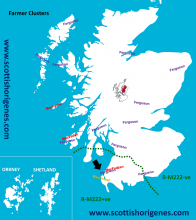 This reveals that the test subject’s paternal ancestor had crossed into Ireland and settled in Inishowen in Northwest Ireland in around the 1st Century AD. His paternal ancestors lived there for hundreds of years until one particular paternal ancestor decided to take part in the Hiberno-Norse Conquest of Southwest Scotland in around 1100AD. By that time surnames were well established in Gaelic society and many of the Inishowen Irish Gaels arrived in Southwest Scotland with their surnames, but some would acquire new surnames as they spread throughout Southwest Scotland. At this point in history his paternal ancestor had begun the process of evolving from an Irish to Scottish Gael. However, by 1600AD his paternal ancestor had further evolved into an English-speaking Protestant Lowlander Scot and it was time for his paternal ancestor to return to Gaelic Ireland during the Plantation of Ulster that began in 1610AD.
This reveals that the test subject’s paternal ancestor had crossed into Ireland and settled in Inishowen in Northwest Ireland in around the 1st Century AD. His paternal ancestors lived there for hundreds of years until one particular paternal ancestor decided to take part in the Hiberno-Norse Conquest of Southwest Scotland in around 1100AD. By that time surnames were well established in Gaelic society and many of the Inishowen Irish Gaels arrived in Southwest Scotland with their surnames, but some would acquire new surnames as they spread throughout Southwest Scotland. At this point in history his paternal ancestor had begun the process of evolving from an Irish to Scottish Gael. However, by 1600AD his paternal ancestor had further evolved into an English-speaking Protestant Lowlander Scot and it was time for his paternal ancestor to return to Gaelic Ireland during the Plantation of Ulster that began in 1610AD. 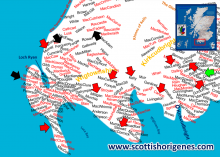
There is a final twist, the test subject’s Y-DNA results reveal his Plantation Scots ancestor settled near Ballymena Town in County Antrim close to Randalstown where he records his earliest ‘Catholic’ Irish ‘Gillen’ ancestor. This indicates that a non-paternal event has occurred in Antrim which saw a dramatic change in identity from Protestant Planter Scot to Catholic Gaelic Irish. What will your DNA reveal, and where will your DNA journey take you? Contact Scottish Origenes (click here) for a FREE CONSULTATION! Or Email: tyronebowes@gmail.com


